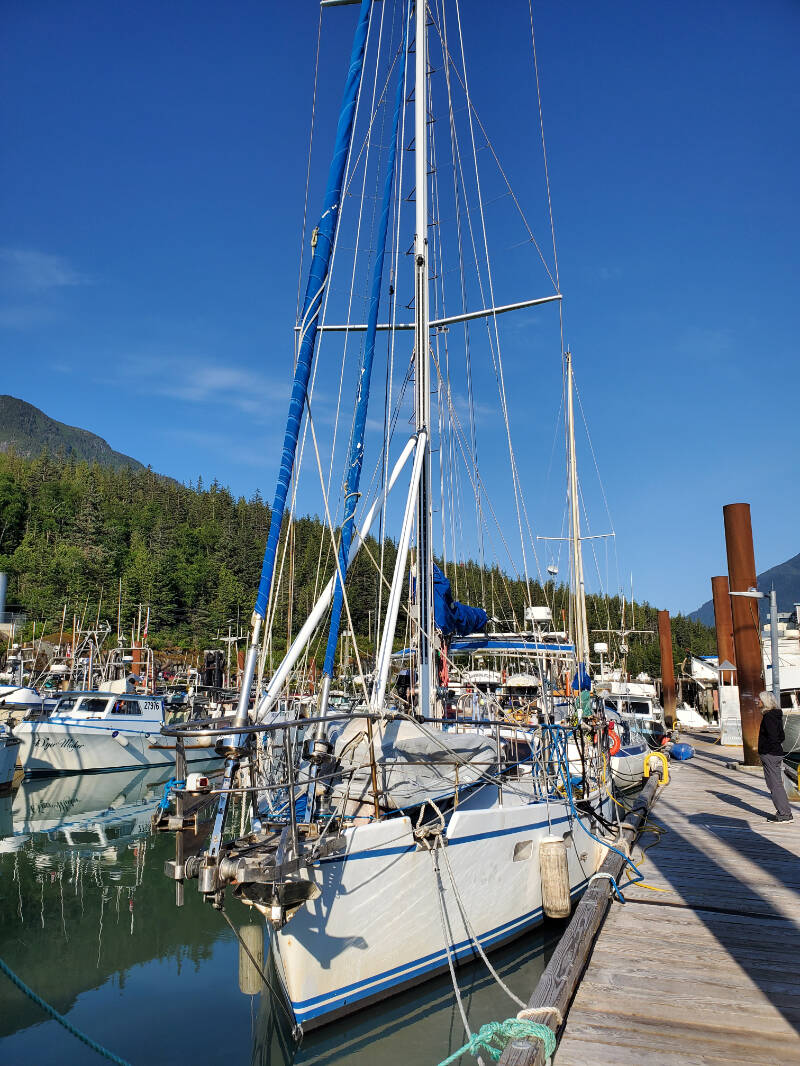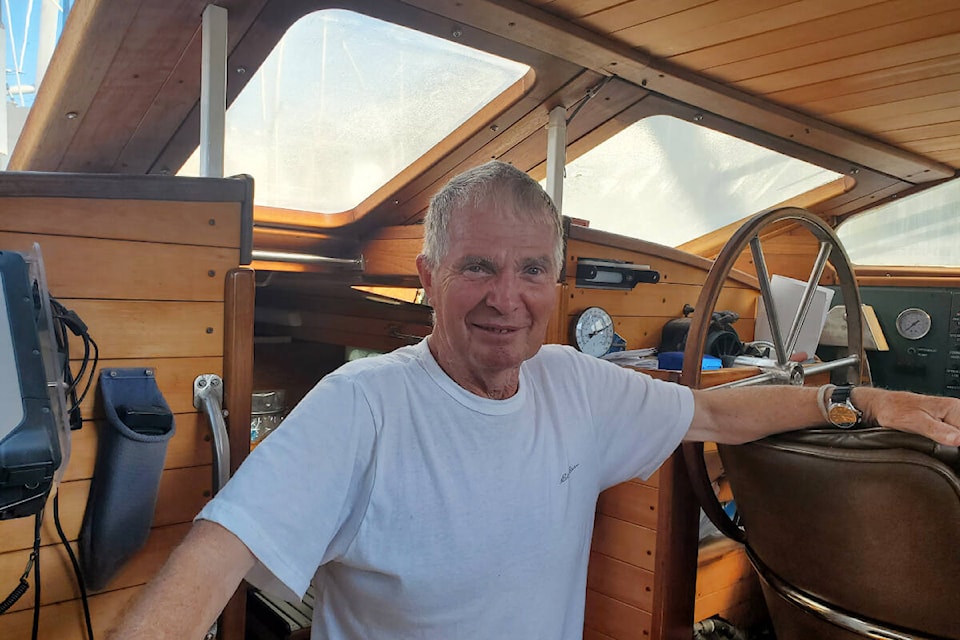Rob Skelly is the type of person who can make you believe difficult things are easier to do than you think.
Between 2017 to 2021, the retired Bella Coola helicopter pilot sailed around the world in a boat he built himself.
“If I can do it at the age of 70, with no offshore experience, anybody can,” he said.
“If you know how to navigate and you know a bit about weather then it’s a very doable thing.”
With GPS, satellite phones and automatic identification systems a person cannot get lost, which is something many people worry about, he added.
Skelly named the 40-ft steel sailboat the Pauline Claire after his only daughter who died of leukemia in 2002 at the age of 19.
Before she died, his daughter gave him some sound advice.
“‘Life’s precious dad, don’t waste a minute,’ she told me.”
Today he lives on the boat near Pender Island.
In June 2023 he sailed up to Bella Coola and anchored at the harbour for a couple of months.
“You spend 35 years in a place, you have lots of friends,” he said, adding his helicopter career was based in Bella Coola.
“I came up here last summer and had a good time and thought I might as well do it again this summer.”
To build the boat, Skelly purchased a plan from Bruce Roberts Designs.
“I picked one mainly as a live-aboard because I had no place to live,” Skelly explained.
“I wanted one with lots of living space underneath which means a very small cockpit. It turned out to be very beneficial for offshore sailing.”
The plans, which cost $1,000, came with a CD containing the digitized design for all the material pieces of the boat.
AJ Forsyth, a metal processing company in Delta, cut out all the pieces, sprayed them with a primer to keep them from rusting. All the alignment lines and part numbers were lasered on each piece.
“It’s just paint by numbers and patience,” Skelly suggested. During the nine years he spent assembling the boat, he rented a shop in Hagensborg and then a space in the shop, for another four years he worked in the shop yard to finish the boat and do the final painting.
“I built it as I could afford it.”
In September of 2016 he sailed from Bella Coola to Pender Island with a friend who had worked as a fisherman on Haida Gwaii and had lots of boating experience.
He stayed for a year at Pender Island, where he practised sailing but mostly worked on the inside of the boat preparing for his trip around the world.
“It was launchable, but it wasn’t very comfortable, certainly not for any offshore sailing. It had to be equipped differently with self-steering gear in the back and a variety of things like that.”
Originally he thought the trip would take him three years.
He knew he’d be following favourable weather patterns and visiting relatives, but the COVID-19 pandemic tacked on another year because of port closures.
Departing from Pender Island in September 2017 he sailed to California to visit a sister who lives on the outskirts of Los Angeles and stayed the winter.
From California he went to French Polynesia for three months and then across to Tonga.
“I hung around Tonga for two months. It was a very pleasant place and I met up with some of the sailors I’d met in French P0lynesia.”
Once the right weather window opened up he headed to New Zealand.
Before becoming a pilot he had pursued a degree in Zoology and lived in New Zealand attending university at Palmerston North.
“I had lots of old flatmates and university friends to visit.”
His next leg of the trip took him to Queensland.
He spent four-and-a-half months in Australia, visiting relatives.
Crossing the Indian Ocean to South Africa was an intimidating part of the trip, because conditions can be unpredictable, he said.
“There are a lot of scary stories.”
He successfully got to his destination and spent time visiting relatives in South Africa, leaving his boat in Durban while he toured the area.
He would have stayed longer but his visa was only for 90 days.
South Africans told him not to attempt going around down to Cape Town before New Year, so he waited and when his visa ran out in the middle of February he headed out toward St. Helena Island.
COVID-19 was just starting to be mentioned around then and the harbour master at St. Helena told Skelly he was hearing about a virus and said they were maybe going to have to make some regulations about people coming and going.
Skelly stayed for six days and running into more friends he’d met on the Indian Ocean.
“It’s kind of like a parade,” he explained. “You are meeting the same people over and over. Everybody is doing the same thing and the same route.”
St. Helena Island had excellent facilities to restock and a week later he arrived at Ascension Island, which he described as the dividing point where sailors either head to the Mediterranean or the Caribbean.
“I was going to the Caribbean.”
About then COVID was getting more serious and his sister suggested he stay at Ascension Island for a week or two, which turned into seven weeks.
“I had no place to go because many ports were shut down so I stayed until the main storm of COVID blew over.”
When Grenada and St. Lucia opened up he prepared to leave.
Before he left he obtained a letter from the chief medical officer on Ascension Island, something his sister had suggested he do.
The letter confirmed Skelly did not have COVID and that there was no COVID on Ascension Island.
He headed to Grenada and was able to get in without having to quarantine because of the letter.
Already behind schedule, he was delayed further because Panama was not letting pleasure boats through the canal for a period of time.
“I waited in Grenada for nine months to get the right weather to cross the Pacific from Panama to Hawaii, but it wasn’t a bad place to hang out while the rest of the world was freaking out about COVID.”
Once Panama opened up to pleasure boats, he went through the locks tied up with two other boats.
“After you get through the locks you spend a whole day overnight in a lake in Panama. Then you travel a good deal through the lake and up a river until you get to the outlet on the Pacific side.”
From Panama to Hawaii he spent 47 days, his longest stretch on the trip.
He stayed in Hawaii for a month and it was there he got his COVID vaccines.
“I was lucky that I did because having the vaccines made entering into Canada easier and it was another hurdle I didn’t have to jump over.”
Sailing from Hawaii he had 10 to 12 days of “miserable” weather.
“The wind was behind me but it was a rough section. It took a lot longer than it should have.”
He bypassed a couple of storms and then about 500 miles west of Cape Scott, on the northwestern tip of Vancouver Island, where he hoped to make a big loop to make use of the wind, he hit the starter and it wouldn’t start.
“I tried to fix it. I called some mechanics but I could not get it going.”
Fortunately, the wind came back up and he was able to sail towards Vancouver Island, down along the coast to Tofino, Ucluelet and Bamfield.
At Bamfield he decided he was tired out and just needed to get home so he called a company to come and tow him to Port Renfrew.
He had to stay on board until a Customs crew came from Victoria and signed him into the country, he recalled.
When asked if he kept a journal of his journey, Skelly said he started to but only kept it up for a month.
He did keep track of how many miles he did on any given day and the hours of engine time, which is used for making sure oil changes are kept up to date.
The whole adventure was possible with the help of many friends and the support of his family, he said.
“In both the construction and the sailing, and in particular my sister Joy who provided me with up-to-date weather information along the way that was invaluable.”
When asked what was the most enjoyable part, Skelly paused before giving a thoughtful reply.
“It was the sense of accomplishment, as an old guy managing a completely new life just by giving it a try,” he answered.
READ MORE: Local launches sailboat built by hand at Bella Coola Harbour
READ MORE: CASUAL COUNTRY: Airtanker pilot based in Williams Lake likes Cariboo life
Want to read more local stories like this? Sign up for the Williams Lake Tribune’s newsletter right to your email. Consider purchasing a subscription to the Tribune to support local journalism for just .99 cents per week!

